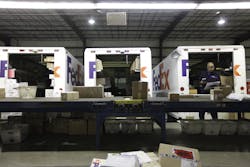The rapid rise of e-commerce activity and the shipping demands it drives may generate an array of permanent changes to global transportation and logistics practices – the biggest being higher freight rates for moving goods around the globe.
In report issues earlier this summer, Sumesh Rahavendra, head of marketing for DHL Express Sub Saharan Africa, stressed that “e-tailing” – the sale of goods and services through the Internet – has exploded globally, especially in emerging countries and it is clear e-tailing “will continue to boom,” he said.
“Currently, e-commerce already makes up 8% of the overall trading volume in Europe,” he explained in a DHL-back report dubbed Global E-Tailing 2025. “Depending on the scenario, this share could rise up to 40% in developed countries and up to 30% in today’s emerging markets."
Rahavendra added that the factor that all the future global-commerce scenarios DHL studied have in common is that the competition in electronic retail, whether on global, national or regional level, will become more intense.
“We don’t know for certain what the world will look like in 2025, but the study’s various scenarios show how rapid the global retail sector, both online and offline, is changing and that logistics will be a focal point of these change processes,” he stressed.
“While e-tailing can facilitate the transaction of the changing consumer trends, the delivery of the product needs to be considered,” Rahavendra pointed out. “Many retailers put significant focus to attract customers, but more effort needs to be paid to facilitating flawless delivery to customers. Even more so when deliveries begin being measured in minutes, as opposed to hours and days. This will require logistics to adapt, as well as deliver competitive advantages, such as offering same day delivery and flexible returns.”
David Ross, a managing director with Wall Street investment firm Stifel, Nicolaus & Co., noted in a research brief issued in late June that FedEx Corp. and United Parcel Service are planning to change to dimensional weight (DIM) pricing on all ground packages immediately after the upcoming holiday season – meaning that e-commerce shipments will become much more expensive to ship.
“For starters, e-commerce packages tend to be bulkier and lighter-weight than B2B [business-to-business] shipments [and] as the percentage of total, B2C [business-to-consumer] shipments have grown from roughly 20% of carrier volume to over one-third of package volume just in the past five or so years,” he explained.
“Blurring the numbers is the fact that a lot of B2C shipments look like B2B shipments, because customers get packages delivered to their work address rather than to the home, so we believe B2C penetration is actually closer to 45% to 50%” of overall volume at FedEx and UPS, Ross said.
As the B2C packages are bulkier but also lighter-weight, this means the parcel carriers can now fit fewer packages in each truck and in each trailer, he added.
“And with the lower average weight, that means the companies’ cost per package has increased, while revenue per package has fallen,” Ross noted. “To better match the carriers’ cost (cubic capacity) with revenues (price per package), UPS and FedEx are moving to DIM pricing for all ground shipments, just as is already common practice in express networks.”
DHL’s Rahavendra added that another wrinkle will be added over the next decade by the creation of what he subbed a “true model” of “Everywhere Commerce,” where smartphones and tablets remain consumers’ constant companions.
“Interactive displays are ever-present in city streets, serving as interfaces to the virtual world, and the retail sector targets customers through a variety of channels, such as these interactive displays, as well as offers their goods online and in stationary stores, which results in consumers being able to access and purchase products at all times,” he said. “In the future, logistics will take over the role as an enabler for such online retailers even more so than today.”
Yet such e-commerce-focused logistics services will also come with a higher price tag over time, Stifel’s Ross believes.
“E-commerce has had a very significant record of growth, as no sales tax [has] allowed online vendors to offer a competitive price versus traditional storefront outlets. And ‘free shipping’ offers has allowed the run to continue,” he explained. “But as FedEx and UPS alter their pricing to address the mix change seen in their small package networks … we believe B2C shipping costs should continue to rise.”
In Stifel’s analysis, “e-tailers” will then be faced with only two options: eat transportation pricing increases and suffer lower margins as a result, or pass on the increase to their customers.
“With already thin margins, we believe most e-tailers will pass the increase along to the customer in terms of either higher unit prices on goods or by passing the shipping costs on to the customer,” Ross said. “Shipping is never ‘free’ – someone is paying for it. Trucks aren’t free, fuel isn’t free, and drivers are certainly not free.”
About the Author
Sean Kilcarr
Editor in Chief
Sean Kilcarr is a former longtime FleetOwner senior editor who wrote for the publication from 2000 to 2018. He served as editor-in-chief from 2017 to 2018.
